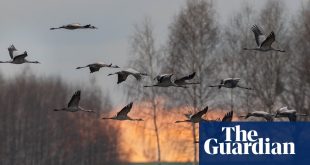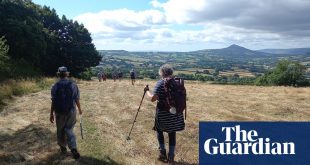Drones circling above the peaks of Snowdonia, providing an airborne mobile network in remote areas, may soon become a feature of the region’s mountain rescue operation.
The drones – like small unmanned gliders but with twin engines – would carry equipment providing 4G and 5G connectivity that would link mountain rescue teams and other emergency services with people stranded, lost or injured in remote hills where the mobile phone signal is often patchy or nonexistent.
Drone mobile support could allow rescuers to pinpoint the location of a lost walker and guide them down a mountain, or link a doctor with someone trying to help a badly injured person. Walkers and rescuers could also share images or communicate by video, providing more detailed information on those in difficulty.

A prototype of the “Dragon” drone, which has a wingspan of about seven metres, has been built by the Snowdonia Aerospace Centre and successfully tested on flights from Llanbedr airport in Gwynedd. The plan is to run trials with rescuers and the emergency services next year.
David Owens, head of technical trials at Virgin Media O2, which is developing the airborne network system, said it was a first for the UK. “National parks don’t have fabulous coverage because of the nature of the terrain and you don’t want areas of outstanding natural beauty covered in mobile phone masts. It means there are lots of constraints on what we can do.
“We got to wondering whether we could put together something that would allow us to provide coverage by flying a network into these areas on a drone.”
The Dragon drone would be able to circle – or “loiter” – for four or five hours above a mountainside and there are plans to find ways of extending the flight time to more than 12 hours.
Owens said the system could also be used in maritime rescues, for example to communicate with offshore paddleboarders or swimmers.
Mountain rescue teams responded to a record 3,629 callouts in England and Wales in 2021, almost 1,000 more than the yearly average before the Covid pandemic.
New research from Virgin Media O2 shows that 63% of Britons visited at least one UK national park in the past year. However, getting lost (35%), injured (33%) and being unable to contact anyone (31%) were some of the key concerns of people considering a walking holiday.
Sgt Paul Terry of the North Wales police drone unit, who is also a member of Ogwen Valley mountain rescue, said the drone system could be a “gamechanger”.

As well as linking rescuers with hikers or climbers, it would help connect the various emergency responders, which might be especially useful in complex operations such as the one that followed a helicopter crash in Snowdonia in 2017, when five people died.
Terry said Ogwen Valley mountain rescue typically deals with about 160 incidents a year and had been called out 140 times so far this year. A neighbouring team, Llanberis mountain rescue, is called out about 200 times a year. “We’ve seen an explosion of people out in the mountains,” Terry said. And people are tending to head for riskier spots, with social media making spectacular but potentially dangerous areas such as Snowdon’s Crib Goch ridge walk more popular.

Terry said he often met people navigating with their smartphone using maps that did not give enough detail, and believes mobile phones can give inexperienced walkers a false sense of security. “They haven’t considered that if they need it later it may not be charged or they won’t have a signal.
“With more and more people visiting Snowdonia each year, a drone with mobile connectivity would be a powerful tool for the search and rescue teams to understand and assess a situation immediately, saving crucial time in life-threatening situations.”
The Welsh economy minister, Vaughan Gething, said: “Connectivity is the bedrock of our digital world. It brings us all closer and is especially important in situations concerning safety. I am delighted we are supporting this innovative project, which further demonstrates how technology can help us problem-solve and improve our lives.”
The project has been funded by the Innovate UK Future Flight challenge and a Department for Transport drone technology research and innovation grant. It also involves SwiftFlight Avionics, Wavemobile and the Welsh government.
 Top Naija News: Nigerian News, Breaking News Nigeria and World News Top Naija News is a daily news publication in Nigeria, delivering the latest breaking news in Nigeria and around the world.
Top Naija News: Nigerian News, Breaking News Nigeria and World News Top Naija News is a daily news publication in Nigeria, delivering the latest breaking news in Nigeria and around the world.



